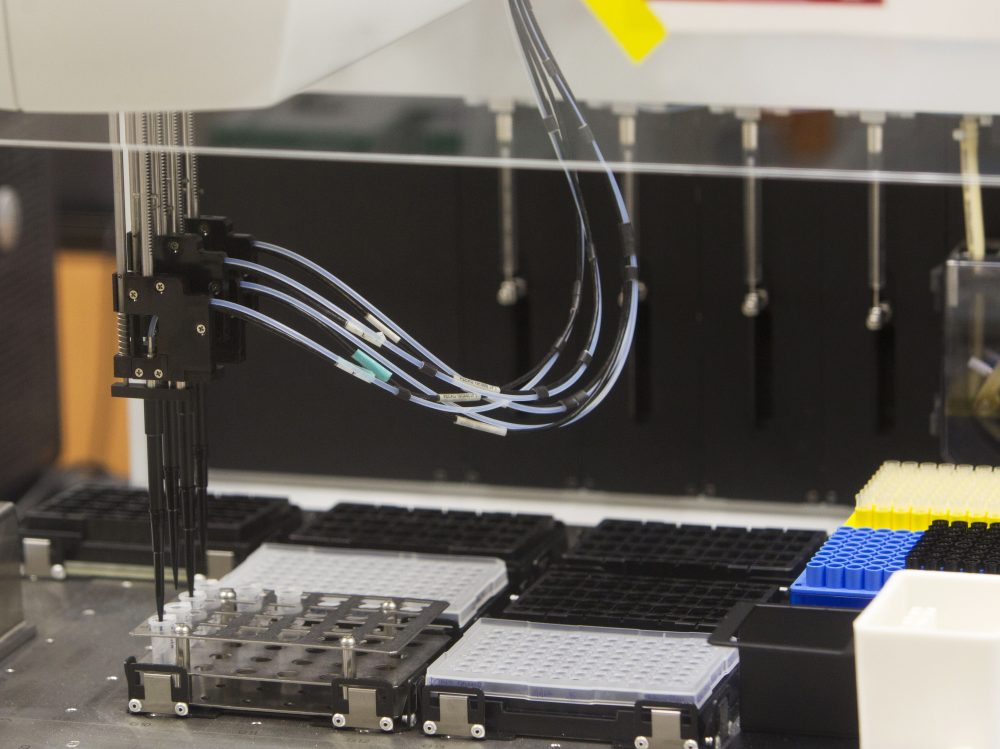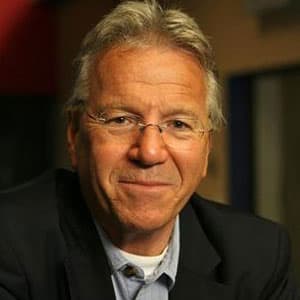Advertisement
Standard DNA Testing Can’t Differentiate Between Identical Twins. A New Test Challenges That
Resume
Telling one identical twin from another poses problems for police. And it goes beyond appearances.
That's because DNA profiling may be the gold standard for bringing criminals to justice, but when it comes to identical twins, standard testing can’t tell the difference.
So when crime scene DNA showed a match to a suspect in two rape cases in Boston in 2004, it showed a match to his twin brother as well.
Now, a Suffolk County prosecutor is trying to persuade a state judge to make her court the first in the country to admit a new forensic test that points to one of the twins — and not the other.
The Scientific Legal Loophole Of Identical Twins
The case of 36-year-old Dwayne McNair of Dedham demonstrates the already long and powerful reach of DNA science that first came to a courtroom trial in 1987.
And Suffolk County prosecutors hope to extend that reach even farther.
The issue begins with the savage and separate assaults of two women abducted, pistol-whipped and raped by two men in Dorchester.
Prosecutor David Deakin said that as the victim of the second assault was putting her clothes back on, she did something extraordinarily brave.
"Nearby was a used condom that one of the perpetrators had used during the sexual assault," Deakin said, "and she scooped the condom up in the cups of her bra, and then put the bra in her pocket."
That gave police a semen sample from the unknown rapist and thus a DNA "fingerprint." Several years later, when a couple of Boston cops got a tip that McNair might be worth investigating, they tailed him to work. They watched him smoke a cigarette, then picked up his discarded stub -- the source of another DNA fingerprint. It matched the DNA in the condom.
Case solved, you might think. Except the detectives learned McNair has a twin brother.
"We obtained a court order for the twins to submit DNA samples, which they did," Deakin said, "and the DNA testing of those samples revealed that they are in fact identical twins. And therefore both of their DNA matched the crime scene sample."
Here was the scientific legal loophole of identical twins: The prosecution could prove to a jury that it was either Dwayne or Dwight McNair who committed the crimes. But it couldn't prove which one.
"Ordinary DNA science, the kind of science that's used around the world every day in courts to identify people, can't differentiate between identical twins," Deakin said.
Scientists in general accept that not every cell in identical twins is exactly alike, that identical twins aren’t exactly identical. But it’s been widely assumed there was no way to tell them apart.
"The understanding was that you just couldn't do it," said Penn State law professor David Kaye, an expert in forensic science, "because they were so similar that the kinds of differences that genetic tests that are used in forensics would pick up just wouldn't be seen in any pair of identical twins."
'Next Generation' Sequencing
Ten years after the crimes, in 2014, Dwayne McNair was about to go to trial when prosecutor Deakin read about advanced technology successfully applied by a German company to tell one identical twin from another.
"Next generation," or "massive parallel," sequencing, as it’s called, enables scientists to map out the genome of each twin. That's the entire set of genetic instructions in the bundles of DNA — the chromosomes — found in every cell.
The goal is to find mutations, those rare events in the process of cell division that occur while each cell is otherwise faithfully copying some 3 billion letters of genetic code. Inevitably, as with every typist, there's going to be a typo.
"You can have a miscopy, if you will, at some point in the DNA sequence," Kaye said. "We'll call that a mutation."
Mutations occur both randomly and rarely. And if a mutation occurs after the twinning process, that gives rise to separate identical twin; it’s thought that the mutation will show up in one twin or the other, but not both.
In its experiment with identical brothers, that German company, Eurofins Forensic, used semen samples to map out the genomes of each twin. When it compared the two genomes, it found five mutations in one twin that were not in the other, thereby demonstrating identical twins could be differentiated.
Then Eurofins sequenced the genome of a child of one of the two brothers on the basis of a blood sample. Researchers found the child had the same five genetic mutations found in one of the identical twins, indicating who was the father and who was the uncle. The experiment offered evidence that mutations will carry to body tissue and semen.
Deakin realized the possibility the Eurofins test could compare the sperm sample of the unknown suspect with the saliva of the two McNair brothers.
"What Eurofins did was the first to publish a study showing that using this technique, you can identify the source of an unknown sample," Deakin said.
With time running out before Dwayne McNair went to trial in Boston in 2014, the Suffolk County district attorney hired Eurofins to test the McNair brothers’ saliva samples and the semen from the crime scene. And Deakin went to court to withdraw the charges against Dwayne McNair to wait for the results of genome sequencing on the twins.
They found nine differences out of 3 billion.
Now came the novel and controversial part of the test. After establishing the genetic differences, Eurofins compared both DNA profiles from the saliva with the DNA of the semen found in the suspect's condom.
Analysts found seven locations where the DNA of Dwayne McNair's saliva showed a match, and two where his brother Dwight matched.
Even more telling, scientists found two of the mutations in Dwayne's saliva were also present in the semen sample. In Dwight’s case, none were present.
On that basis, Eurofins concluded Dwayne McNair was 2 billion times more likely than Dwight to be the source of the semen and therefore the rapist. And in September 2014, Dwayne was once again indicted on charges of rape and armed robbery.
Ready For 'Prime Time'?
McNair's defense was to try to exclude the new tests and evidence from trial.
Robert Tobin, his attorney, characterized the defense by saying "that the test isn't ready yet for forensics." Tobin added: "It hasn't been vetted and researched by independent scientists. ... I mean, it’s an interesting experiment but it just isn't ready for prime time."
In hearings over the course of three weeks and just concluded, the defense and the prosecution called to the stand a string of molecular geneticists, biostatisticians, embryologists, forensic experts and a former top scientist at the FBI’s DNA lab.
McNair’s defense established that the technique that implicates him has never been admitted to a courtroom anywhere in the world. It’s the product of only one experiment using only one set of twins. There has never been a DNA study of, say, 20 or a hundred sets of identical twins, published and peer-reviewed, to corroborate the findings or the foundations of what Eurofins has done.
"Given the way that most forensic tests are validated, and should be validated according to many scientists, this test has not been validated yet in that manner," professor Kaye said.
One of the most complicating and controversial issues is that the DNA of the sperm is being compared to the DNA from saliva.
Professor David Housman of MIT, who has a long history of testifying for the prosecution, testified this time for the defense.
"If they had obtained semen samples from both twins and one of the twin's semen samples matched the crime scene samples, then I would not have a problem with it," Housman said.
It would be far simpler if scientists could sequence the DNA of both twins' semen and then match them against the semen taken from the crime scene. But compelling someone to provide semen samples would be a violation of his Fourth Amendment rights against unreasonable search and seizure. So saliva samples, considered minimally intrusive, had to substitute as a proxy tissue. And witnesses questioned whether the saliva and the semen all have the same DNA.
"The issue of which twin is necessarily the donor of the sperm cannot be ... proven beyond a reasonable doubt," Housman said.
This isn't the first time Deakin has prosecuted a rape case complicated by identical twins both matching the DNA. But his expert witnesses testified to the rock solid quality of the technology.
Deakin has confidence in the evolving science.
"While it is indisputably a novel approach, we expect to prove it’s a reliable one," he said.
Now Superior Court Judge Linda Giles must decide whether the test and its results are ready for prime time.
If the prosecution is denied the use of the new evidence, it will still have the evidence from conventional DNA testing that narrows the suspects to one brother or the other.
But the prosecution will also have as a witness a man who has admitted to being the other rapist of the two women in this case.
In still another example of the far reaching power of DNA, that defendant was identified by a national DNA database, which showed he matched the DNA in a rape kit from one of the victims.
Correction: An earlier version of this story incorrectly reported Robert Tobin's first name. We regret the error.
This article was originally published on March 07, 2017.
This segment aired on March 7, 2017.
